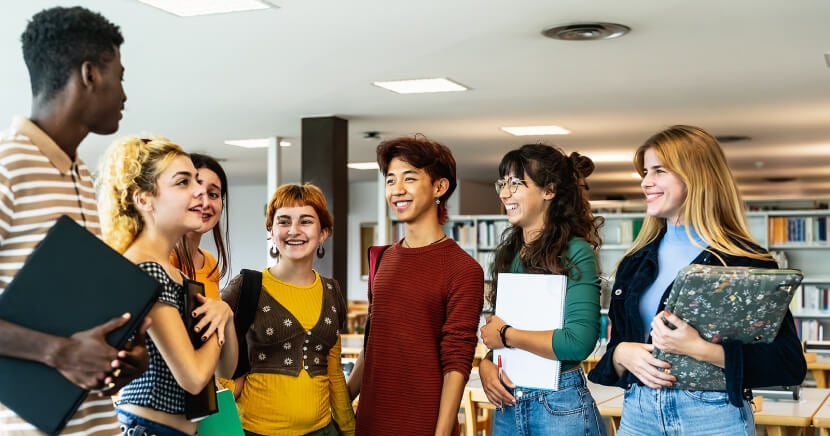Global Information and Media Literacy Week is still over a month away, but it's never too soon to start talking about the ways that libraries can help patrons hone their own critical thinking skills.
Libraries of all types — including K-12, academic and public libraries — can play a crucial role in helping patrons recognize and combat misinformation. For example, they can encourage patrons to consult library staff when they encounter questionable information in books, periodicals or digital resources. A librarian's information literacy expertise can guide them through evaluating the information's credibility.
Here are some other strategies that libraries can employ to help individuals improve their research, verification and critical thinking skills:
Information literacy programs
Let's start by defining information literacy. According to the Association of College and Research Libraries, information literacy is "the set of integrated abilities encompassing the reflective discovery of information, the understanding of how information is produced and valued, and the use of information in creating new knowledge and participating ethically in communities of learning".
Why is it important? Information literacy empowers people to learn for themselves so that they can make more informed decisions. It helps them recognize biases, understand context and evaluate information so they can effectively use and communicate it. It’s a lifelong skill set that meaningfully impacts every person’s education, career, civic engagement and personal life.
Libraries can offer workshops on how to evaluate the credibility of sources, identify biased or false information and use fact-checking tools effectively. They can do so by creating and sharing online resources or tutorials that teach patrons how to distinguish reliable information from misinformation.
Curated collections
Libraries can provide access to reputable fact-checking websites and tools, like the Snopes FactBot, FactCheck.org, or Poynter’s International Fact-Checking Network.
Librarians can also point patrons in the direction of vast array of tools and resources available through the library. These can include collections of books, articles and databases that are known for their credibility and reliability. Unlike potentially biased web search results, curated library resources offer a more balanced and trustworthy perspective.
They can also include quality sources of journalism, including many of the 7,000-plus international newspapers and magazines on the PressReader platform, which includes trusted media outlets like The Guardian, The Economist, The Wall Street Journal and The Globe and Mail.
Digital literacy initiatives
According to Pew Research Center, half of adults in the United States get their news at least some of the time from social media platforms such as X and Facebook, and about one in five get their political news primarily from social media. In a Pew survey, half of 18- to 29-year-olds in the US reported that they have some or a lot of trust in the information they get from social media sites.
This puts the share of adults under 30 who express at least some trust in information from social media at its highest-ever level and the share with trust in national news organizations (56%) at its lowest.
This is concerning for society because other data (also from Pew) suggests that people who mainly get their news in this way are less engaged and less knowledgeable. Social media feeds can create an echo chamber where individuals are exposed to information that aligns with their existing beliefs, limiting exposure to diverse opinions. Additionally, social media posts shape an individual's perception of information, often influenced by their personal browsing behaviors.
Libraries can do their part to reverse this trend by offering guidance on how to navigate social media responsibly, including recognizing fake news, bots and deepfakes. In addition, they can provide resources that encourage critical thinking, civil discourse and skepticism towards sensational headlines or unverified claims.
Public awareness campaigns

Libraries can encourage critical thinking by displaying materials that explain common misinformation tactics and how to spot them.
The News Literacy Project, for example, offers a number of downloadable infographics, including the following:
Libraries might also consider hosting discussions with experts on media literacy, journalism ethics and the impact of misinformation on society — and get the word out via PressReader. After all, PressReader is more than just a way to give patrons access to third-party newspapers and magazines. With PressReader’s Self-Pub feature, libraries can also share their own content by digitizing and uploading their own newsletters, announcements and other publications.
Collaboration with schools and school librarians
Libraries can work with local schools to integrate media and information literacy into the curriculum, ensuring that students learn to recognize misinformation early on.
To help educators get started, several years ago PressReader developed a Media Literacy Toolkit for use in the classroom, at the school library, or even at home to encourage students to take a critical look at the messages they read, see and hear on a daily basis. The Toolkit includes a number of interactive activities, including:
Evaluating news
In this activity, students look at newspaper coverage of a recent front-page event and evaluate the information it provides. By exercising analysis and critical thinking skills, they improve their media literacy and gain an understanding of the vital role the press plays in informing the public.
Exploring author bias
Most journalists try to keep their personal beliefs out of their stories, but sometimes, they sneak in anyways. In this activity, students will dig deep into one writer’s background to see if any bias has made its way into their story.
How to spot fake news
As more people get their news online, it is increasingly vital that students know how to verify sources and spot fake news or images, which often appear indistinguishable from reliable sources. In this activity, students will look for clues in a story, video or photo that can help them determine whether or not it’s real.
Critical thinking for underserved communities

Libraries might also partner with local organizations to extend information literacy education to broader audiences, particularly underserved communities.
Underserved communities often face misrepresentation or underrepresentation in mainstream media. Media literacy enables members of these communities to recognize and challenge stereotypes and biases in media content.
To support these efforts, libraries can curate a diverse collection of books, magazines, newspapers and digital media that reflect the cultural backgrounds and interests of the community. This helps individuals explore different — even opposing — perspectives and avoid getting trapped in an ideological bubble when they consume information.
Librarians should also ensure that materials and programs are accessible to non-English-speaking communities by offering resources in multiple languages. PressReader, for example, provides access to publications from all over the world in dozens of languages, and also has translation features, including Auto-Translate.
Support for critical media consumption
As you can see, when it comes to critical thinking, library professionals have a lot to offer patrons. Here are just a few more ways they can help:
One-on-one tutorials: Offer personalized sessions to help individuals improve their research and verification skills.
Browser extensions and apps: Introduce patrons to tools like browser extensions that flag questionable content, such as NewsGuard or Hoaxy.
Interactive quizzes: Develop or promote quizzes that test and enhance patrons’ ability to distinguish between real and fake news.
Book clubs and discussion groups: Facilitate discussions around current events and media, encouraging critical analysis to promote civil discourse about different opinions and perspectives.
Guest speakers and workshops: Invite journalists, media experts, or educators to speak about the importance of credible information and the dangers of misinformation.
These strategies can empower library patrons to navigate the information landscape more effectively, helping them become more discerning consumers of news and information.









